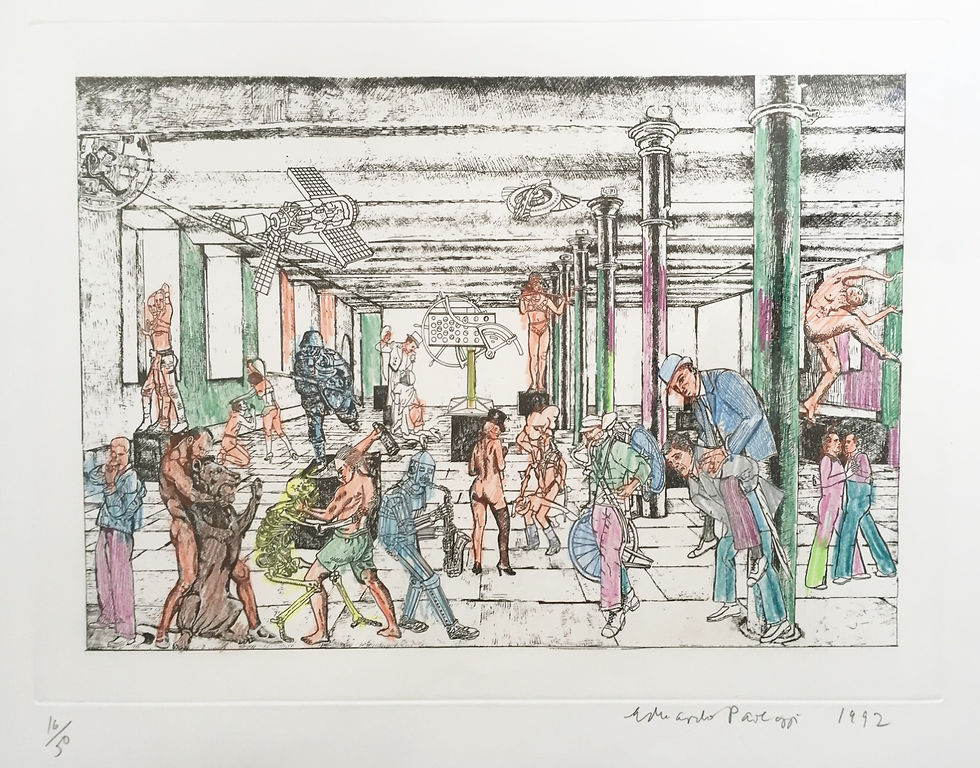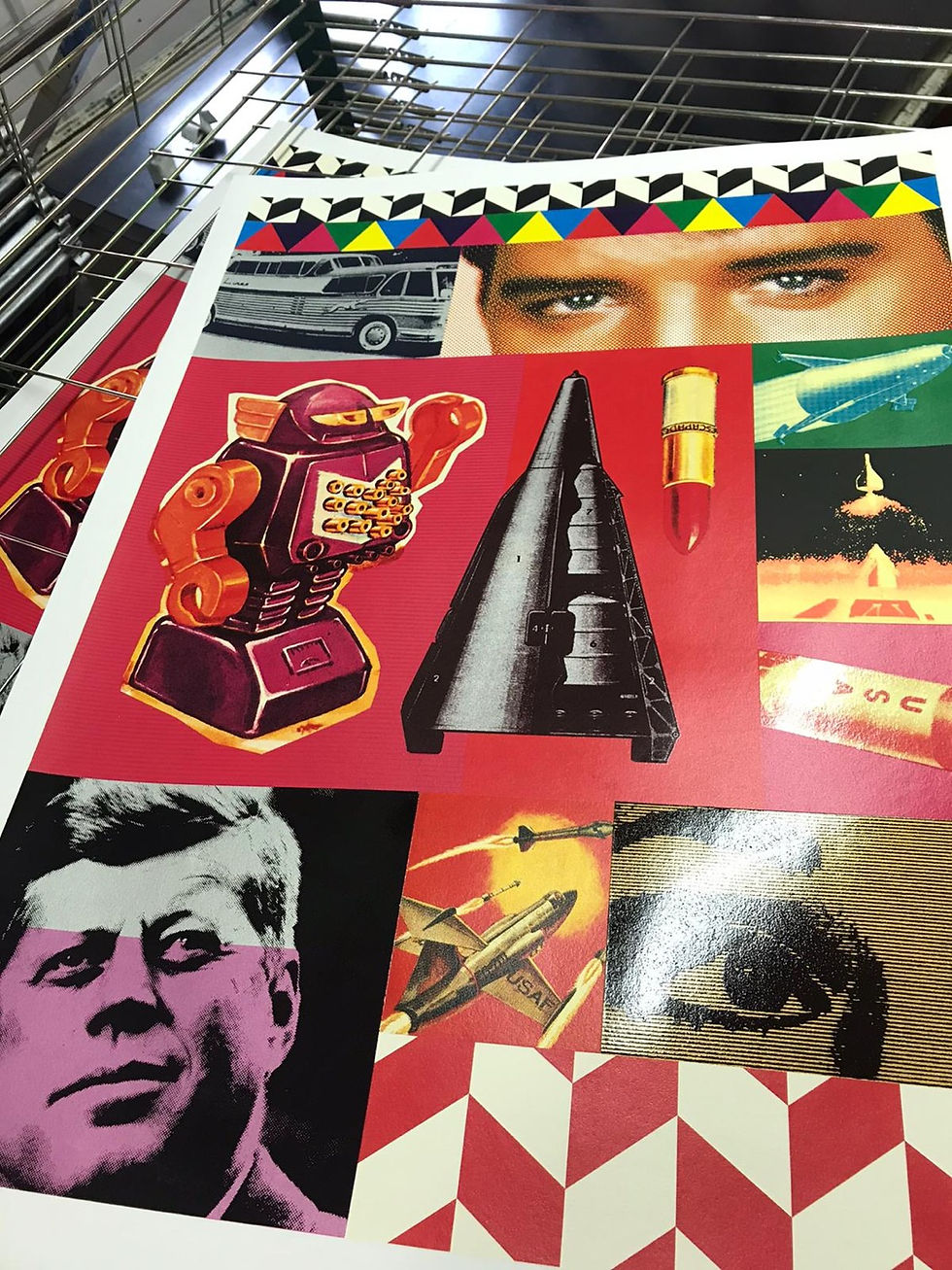Pop Art Editions
- James Stewart
- Jun 2, 2021
- 6 min read
Updated: Sep 15, 2021
This month, we will look at Pop Art Editions, with a look at its origins in the post war explosion of consumerism and mass media during the 1950’s and 60’s through to links to contemporary artists drawing on these references in their work today.

Pop Art is an art movement that emerged in the UK and the United States in the late 1950s. The movement presented a challenge to traditions of fine art by including imagery from popular and mass culture, such as advertising (Andy Warhol), comic books (Roy Lichtenstein) and mundane mass-produced objects.
One of its aims is to use images of popular (as opposed to elitist) culture in art, emphasizing the banal or kitschy elements of any culture, most often through the use of irony. It is also associated with the artists' use of mechanical means of reproduction or rendering techniques (e.g. screen printing). In pop art, material is sometimes visually removed from its known context, isolated, or combined with unrelated material (see works of Patrick Caulfield).
Amongst the early artists that shaped the pop art movement were Edoardo Paolozzi, Peter Blake and Richard Hamilton in the UK, and Robert Rauschenberg & Jasper Johns among others in the United States.
Pop art is widely interpreted as a reaction to the then-dominant ideas of abstract expressionism, as well as an expansion of those ideas. Due to its utilization of found objects and images, it is similar to Dada (see also Marcel Duchamp). Pop art and minimalism are considered to be art movements that precede post modern art, or are some of the earliest examples of postmodern art themselves.
Richard Hamilton famously said in 1957:
“Pop Art is: Popular (designed for a mass audience), Transient (short term solution), Expendable (easily-forgotten), Low cost, Mass produced, Young, Witty, Sexy, Gimmicky, Glamorous, Big Business. . .This is just the beginning. . .“
For their 2007 major exhibition reviewing Pop Art, the Gagosian Gallery celebrated the 50th anniversary of this visionary seminal statement.
This exhibition of works by 50 artists, from the 1950’s to date, including many that we would expect to see and also some unlikely ones: David Bailey, Damien Hirst, Cy Twombly to name just three.
The Gagosian 2007 exhibition allowed visitors the opportunity to engage in an artistic dialogue, looking at methods of seriality and repetition, the use of synthetic materials as well as media images, and references to mass production. The conclusion is clear: the concept of Pop is still vital in contemporary art today.
Similarly the Tate drew a direct line from the rich era of creativity in the 1960’s to the 1990’s phenomena of the YBA’s (Young British Artists) and ‘Cool Britannia’, in their 2004 Exhibition ’Art and the 60’s: This Was Tomorrow’.
In the 1960’s Britain was emerging from a period of post-war austerity to ”You‘ve never had it so good” (Prime Minister Harold Macmillan). Popular culture coming across from the USA was booming, with a wave of consumer products and household conveniences.

A small number of artists, mainly associated with the ‘Independent Group’ at the ICA (Institute of Contemporary Arts) starting working with this new popular imagery: pin-up girls, science fiction, car design and cinema.
The Royal College of Art was also an important centre at this time producing a number of artists who supported each other in their enthusiasm for mass culture. They developed a new vocabulary for painting and printmaking, facilitated by a free flow of ideas between different RCA departments, mainly the Graphic and Fine Art Schools. Artists such as Peter Blake, R B Kitaj and Joe Tilson graduated from the RCA in the 1950’s, shortly followed by Derek Boshier, Pauline Boty, Patrick Caulfiled, David Hockney and Peter Phillips.
In 1962 the BBC presented a documentary entitled ‘Pop Goes the Easel’ (links to BBC iPlayer to view programme). It was commissioned from Ken Russell and featured Peter Blake, Derek Boshier, Pauline Boty and Peter Phillips. The first three feature in works in the permanent collection of Pallant House Gallery in Chichester.
Where the USA Pop Artists celebrated products, the UK reflected the huge growth in the culture of celebrity, facilitated by mass media: David Bailey‘s selected a group of ‘in’ people for his ‘Box of Pin Ups’ and Blake used images of Marilyn Monroe and the Beatles.
At Zimmer Stewart Gallery, we have often returned to Pop Art in our exhibitions, including:
In 2004 we were invited to participate in ‘Pop’ as part of the Brighton Fringe and presented ‘maximalist‘ artist Duggie Fields.
In 2005 we showed ‘Masterworks’, an exhibition of editions by Peter Blake, Patrick Caulfield & Howard Hodgkin
In 2012 our exhibition ‘Original Prints’ featured the Wall Plate series of four large screen prints by Patrick Caulfield.
Our selection of Editions would not be complete without there always being some works by these artists.
Below we outline some further background on some of the Pop Artists mentioned above.
Peter Blake is best known for co-creating the sleeve design for the Beatles' album Sgt. Pepper's Lonely Hearts Club Band. His other works include the covers for two of The Who's albums, the cover of the Band Aid single "Do They Know It's Christmas?", and the Live Aid concert poster. Blake also designed the 2012 Brit Award statuette.
In 2020 he created the screen print above to celebrate the Olympics and in support of Team GB. The Olympics will now be held in Japan in July and August 2021. This print encapsulates imagery from the classic Olympic Rings as well as iconic ‘Heart’ symbol, which is present in many of Blake’s works.
One of the best known British pop artists, Blake is considered to be a prominent figure in the pop art movement. Central to his paintings are his interest in images from popular culture which have infused his collages. In 2002 he was knighted at Buckingham Palace for his services to art.
Patrick Caulfield, CBE, RA (29 January 1936 – 29 September 2005), was an English painter and printmaker known for his bold canvases, which often incorporated elements of photorealism within a pared-down scene.
In 1964, he exhibited at the New Generation show at London's Whitechapel Gallery, which resulted in him being associated with the Pop Art movement. This was a label Caulfield was opposed to throughout his career, seeing himself rather as "a 'formal' artist".
‘Dressed Lobster’ (below) was published in 1980, and is one of seven prints commissioned and published to celebrate the Kelpra Studio Exhibition at the Tate Gallery in 1980. The other artists were Gordon House, R.B. Kitaj, Victor Pasmore, John Piper, Joe Tilson and Gerd Winner.
The image shows an outline of a lobster in thick black outline set on a background of foliage, which could almost be wallpaper. This style typical of Caulfield from the mid-60’s to ‘80, leading up to his major retrospective at the Walker Gallery, Liverpool in 1981.
‘Les Chants de Maldoror, Ducasse’ (above) by Edoardo Paolozzi, widely considered one of the pioneers of Pop Art, was published in the 1992 Royal College of Art portfolio "Six Artists". It is an ‘edition variable’ etching with extensive hand colouring, signed, numbered and dated in pencil. Each one is quite different, some even have little or no colouring. This print is framed in a black wood frame. Les Chants de Maldoror (The Songs of Maldoror) is a poetic novel consisting of six cantos. It was written and published between 1868 and 1869 by the Comte de Lautréamont, the pseudonym of the Uruguayan-born French writer Isidore-Lucien Ducasse.
Many of the surrealists (Salvador Dalí, André Breton, Antonin Artaud, Marcel Duchamp, Man Ray, Max Ernst, etc.) during the early 20th century cited the novel as a major inspiration to their own works.
This interpretation by Paolozzi can be viewed in our Editions Shop.
Patrick Edgeley is a Brighton based artist/printmaker who creates limited edition screen prints that employ bold, hand drawn text and imagery. Americana, signs, packaging and pop culture are a great influence in these hand printed works.
He says “I love the whole sequence of actions when producing a print. I tend to push myself to see just what I can achieve, either in number of colours I use, complexity of design or experimenting with techniques. It can be a slow, frustrating process at times when the result doesn’t quite match your expectation, but these moments can also be a positive, steering you into a another direction with the print, helping to shape it like a painting. You simply don’t get with a press of a button on a inkjet printer, each screen print, although subtle, has it’s own uniqueness!” We are currently featuring a series of Edgeley’s contemporary Pop Art editions on our website. These will range in price from £140 to £180, depending on number of colours, metallic layers (silver & gold) and glazes.















Comments